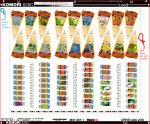Good afternoon guys,
I apologize if I am asking a stupid question but after a couple of hours of trying to identify a solution to my dilema I decided it would be worth a try to publish a cry for help in case somebody would have an idea and would like to share.
Here's my dilemma: I need to be able to output a job ticket including an image of the graphic being worked on, that can be ripped/printed and passed on down for processing. This implies:
1. Being able to shrink automatically the art I am working on to fit to a 11"x17" or an 8 1/2" x 11";
2. Adding infomations to the bottom of the page like: user, media to be used, location of the file, finishing, job number, perhaps a barcode, etc;
3. Rip this file to check for errors on art then prin it on a proofer (say an HP Z2100);
Preferrably this would be done with a plugin directly from Illustrator but any other third party solutions would work.
Until now I looked all over the place and there is no such beast so, has anybody heard/seen anything that would work remotely in this way? Even a combination of solutions would bea posibility.
Any thoughts/suggestions would be greatly appreciated.
Thanks a bunch and Happy Holidays!
I apologize if I am asking a stupid question but after a couple of hours of trying to identify a solution to my dilema I decided it would be worth a try to publish a cry for help in case somebody would have an idea and would like to share.
Here's my dilemma: I need to be able to output a job ticket including an image of the graphic being worked on, that can be ripped/printed and passed on down for processing. This implies:
1. Being able to shrink automatically the art I am working on to fit to a 11"x17" or an 8 1/2" x 11";
2. Adding infomations to the bottom of the page like: user, media to be used, location of the file, finishing, job number, perhaps a barcode, etc;
3. Rip this file to check for errors on art then prin it on a proofer (say an HP Z2100);
Preferrably this would be done with a plugin directly from Illustrator but any other third party solutions would work.
Until now I looked all over the place and there is no such beast so, has anybody heard/seen anything that would work remotely in this way? Even a combination of solutions would bea posibility.
Any thoughts/suggestions would be greatly appreciated.
Thanks a bunch and Happy Holidays!











